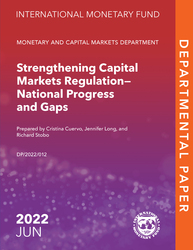
Strengthening Capital Markets--National Progress and Gaps
This paper discusses progress on post-global financial crisis (GFC) reforms and the emerging challenges in the area of capital markets regulation and supervision, drawing on the analysis and insights from the IMF’s Financial Sector Assessment Program (FSAP)
READ MORE...
Volume/Issue:
Volume 2022
Issue 012
Publication date: June 2022
ISBN: 9798400208072
$20.00
Add to Cart by clicking price of the language and format you'd like to purchase
Available Languages and Formats
| English |
Topics covered in this book
This title contains information about the following subjects.
Click on a subject if you would like to see other titles with the same subjects.
Finance , International - Economics , Public Policy , Capital markets regulation supervision , capital markets regulation , derivatives regulator , securities regulator , OTC derivative , reform agenda , Securities markets , Financial Sector Assessment Program , Derivative markets , Financial sector stability , Global
Summary
This paper discusses progress on post-global financial crisis (GFC) reforms and the emerging challenges in the area of capital markets regulation and supervision, drawing on the analysis and insights from the IMF’s Financial Sector Assessment Program (FSAP). FSAP analyses sheds light on the implementation of post-GFC reforms to strengthen prudential and conduct supervision of capital markets and highlights new regulatory and supervisory challenges arising from several factors such as the growth of bond markets, benchmark transition, digitalization, and climate change. Key takeaways regarding implementation of post-GFC reform include significant progress with respect to oversight of market intermediaries and infrastructures and a case for further regulatory and supervisory action to address vulnerabilities arising from the high and rising interconnectedness of the asset management sector with the global economy, especially to foster stronger liquidity risk management. Emerging priority areas underscore the importance of ensuring the adequacy of issuer disclosures and quality of auditing; of examining and appropriately calibrating the regulatory perimeter in light of market developments; and of proactively safeguarding the operational independence of supervisory authorities and adequacy of their resources for implementation of regulatory frameworks that are fit-for-purpose in light of market developments and evolution.
Copyright © 2010 - 2025
Powered by:
AIDC



